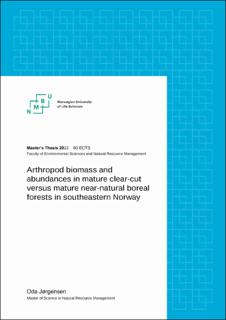| dc.description.abstract | The loss of biodiversity in forest ecosystems has led to a discussion on conservation-oriented forest management, particularly in intensively managed boreal forests of the northern hemisphere. Clear-cutting is the most common forest management practice in Norway today. Clear-cutting differs from other less intensive forest management practices like selective logging which result in a more natural looking and heterogeneous forest (near-natural forests). Many of these clear-cut forests are now reaching maturity making it possible to determine the long-term effects of clear-cutting. Previous studies on effects of clear-cutting have been done, but there is a lack of studies revealing the effects on all arthropods. To assess difference between the two forest management practices on all arthropods, I sampled arthropods in five pairwise plots in southeastern Norway, each pair consisting of one mature near-natural site and one mature clearcut site. Forest stand variables related to forest management, such as deadwood, canopy openness and temperature were also registered. I used three different window trap types as well as malaise traps, and their efficiency at beetle capture was also tested.
I found that clear-cutting had a long-term impact on both arthropod biomass and abundance, as the difference is still clear 70 years after the clear-cutting took place. Overall, the mature clearcut forests had lower total arthropod biomass and abundances compared to mature near-natural forests. The response of different arthropod orders to forest management practice varied greatly between taxonomic orders. Although most orders showed higher abundance and biomass in nearnatural forest, some orders showed the opposite pattern. Previously clear-cut forests are more homogeneous, contain less deadwood and likely attract more generalist species. My results suggest that there might be community differences between the forest management types amongst several arthropod orders, most notably Diptera, Lepidoptera and Collembola. With this study I show the differences between selective logging and clear-cutting as forest management practices on arthropods and the importance of preserving near-natural forests. In addition, my systematic comparison of trap types, shows that traps vary greatly in beetle capture rates and that single pane window traps such as IBL-2 are more efficient than cross-pane traps. | en_US |

